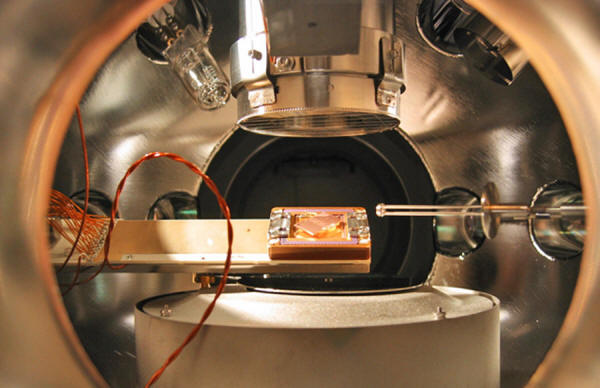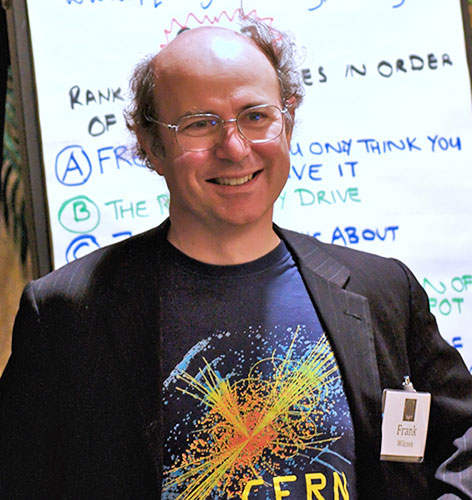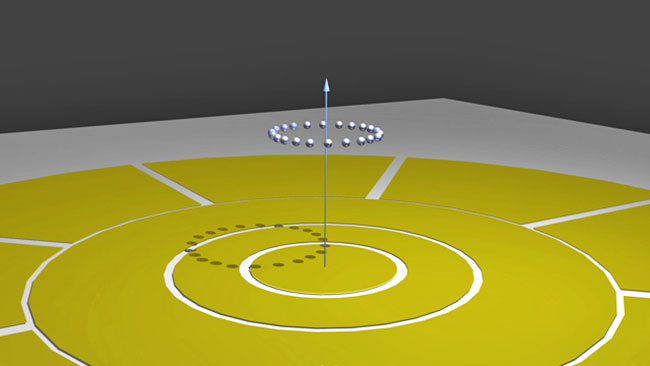|
from QuantaMagazine Website
- a theoretical object that moves in a repeating pattern without using energy -
inside a
device called an ion trap.
A radical theory predicting the existence of "time crystals" - perpetual motion objects that break the symmetry of time -
is being
put to the test...
Impossible as it seemed, Wilczek had developed an apparent proof of "time crystals" - physical structures that move in a repeating pattern, like minute hands rounding clocks, without expending energy or ever winding down.
Unlike clocks or any other known objects, time crystals derive their movement not from stored energy but from a break in the symmetry of time, enabling a special form of perpetual motion.
This, he said, was,
Wilczek's idea met with a muted response from physicists.
Here was a brilliant professor known for developing exotic theories that later entered the mainstream, including the existence of particles called axions and anyons, and discovering a property of nuclear forces known as asymptotic freedom (for which he shared the Nobel Prize in Physics in 2004).
But perpetual motion, deemed impossible by the fundamental laws of physics, was hard to swallow.
Did the work constitute a major breakthrough or faulty logic?
Jakub Zakrzewski, a professor of physics and head of atomic optics at Jagiellonian University in Poland who wrote a perspective (Viewpoint - Crystals of Time) on the research that accompanied Wilczek's publication, says:
Now, a technological advance has made it possible for physicists to test the idea.
They plan to build a time crystal, not in the hope that this perpetuum mobile will generate an endless supply of energy (as inventors have striven in vain to do for more than a thousand years) but that it will yield a better theory of time itself.
When matter crystallizes, its atoms spontaneously organize themselves into the rows, columns and stacks of a three-dimensional lattice.
An atom occupies each "lattice point," but the balance of forces between the atoms prevents them from inhabiting the space between. Because the atoms suddenly have a discrete, rather than continuous, set of choices for where to exist, crystals are said to break the spatial symmetry of nature - the usual rule that all places in space are equivalent.
But what about the temporal symmetry
of nature - the rule that stable objects stay the same throughout
time?
The Nobel Prize-winning physicist Frank Wilczek often develops outlandish theories that eventually enter the mainstream.
"Of course
not everything I do works," he says.
Eventually, his equations indicated that atoms could indeed form a regularly repeating lattice in time, returning to their initial arrangement only after discrete (rather than continuous) intervals, thereby breaking time symmetry.
Without consuming or producing energy, time crystals would be stable, in what physicists call their "ground state," despite cyclical variations in structure that scientists say can be interpreted as perpetual motion.
How can something move, and keep moving forever, without expending energy? It seemed an absurd idea - a major break from the accepted laws of physics.
But Wilczek's papers on Quantum Time Crystals and Classical Time Crystals (the latter co-authored by Alfred Shapere of the University of Kentucky) survived a panel of expert reviewers and were published in Physical Review Letters in October 2012.
Wilczek didn't claim to know whether objects that break the symmetry of time exist in nature, but he wanted experimentalists to try to make one.
(Li said he had been contemplating the idea before reading Wilczek's papers.)
The group's article (Space-Time
Crystals of Trapped Ions) was published with Wilczek's in
Physical Review
Letters.
Bruno thinks Wilczek and company mistakenly identified time-dependent behavior of objects in excited energetic states, rather than their ground states. There is nothing surprising about objects with surplus energy moving in a cyclical fashion, with the motion decaying as the energy dissipates.
To be a time crystal, an object must exhibit perpetual motion in its
ground state.
Wilczek said that although the example is not a time crystal, he doesn't think the error,
The debate will probably not be settled on theoretical grounds.
An international team led by Berkeley scientists is preparing an elaborate lab experiment, although it may take,
...to complete, depending on funding or unforeseen technical difficulties, said Hartmut Häffner, who is co-principal investigator with Zhang.
The hope is that time crystals will push physics beyond the precise but seemingly imperfect laws of quantum mechanics and lead the way to a grander theory.
But in quantum mechanics (the laws governing interactions on the subatomic scale), the time dimension is represented in a different way than the three dimensions of space,
The different treatments of time may be one source of incompatibility between general relativity and quantum mechanics, at least one of which must be altered for there to be an all-encompassing theory of quantum gravity (widely viewed as a major goal of theoretical physics).
Which concept of time is right?
This would suggest that quantum mechanics is inadequate, and that a
better quantum theory might treat time and space as two threads of
the same fabric.
of the time crystal experiment planned at UC-Berkeley. Electric fields will be used to corral calcium ions into a 100-micron-wide "trap," where they will form a crystalline ring. The scientists believe a static magnetic field
will cause the ring to
rotate.
The electric field generated by the electrodes will corral the ions in a "trap" 100 microns wide, or roughly the width of a human hair. The scientists must precisely calibrate the electrodes to smooth out the field.
Because like charges repel, the
ions will space themselves evenly around the outer edge of the trap,
forming a crystalline ring.
According to the group's calculations, the ion ring should settle into its ground state when the ions are laser-cooled to around one-billionth of a degree above absolute zero.
Access to this temperature regime had long been obstructed by background heat emanating from trap electrodes, but in September, a breakthrough technique for cleaning surface contaminants off electrodes enabled a 100-fold reduction in ion trap background heat.
Next, the researchers will switch on a static magnetic field in the trap, which their theory says should induce the ions to start rotating (and continue doing so indefinitely).
If all goes as
planned, the ions will cycle around to their starting point at fixed
intervals, forming a regularly repeating lattice in time that breaks
temporal symmetry.
It will stay bright (and
reveal its new location) when the others are darkened by a second
laser.
Until that happens, some physicists will remain deeply skeptical.
|




